Customer-facing applications, sometimes known as user-facing applications, provide a frontend user interface (UI) that gives consumers an efficient, reliable, and secure means of interacting with your company’s backend software. In some cases, your backend technology might comprise a basic web server or two. Other times, it might encompass dozens of servers with various databases, data backup capabilities, and various network security mechanisms.
Either way, the backend system consists of hardware and software that, for many different reasons, shouldn’t be directly accessible by the average consumer. Instead, companies use their customer-facing applications to facilitate access via the front end as needed.
1. Web Portals
Among the most common customer-facing apps, web portals take on many different forms. In some cases, a basic web portal might comprise only a single webpage. However, they’re usually a bit more complex than that.
Most modern web portals start with a customer login page, which allows customers to enter their username and password, and some might even give customers the option to create their own accounts. However, the content beyond the initial login screen really depends on the industry. In the example below, the Freshdesk web portal’s home page shows options to browse articles, view all tickets, and submit a new ticket.
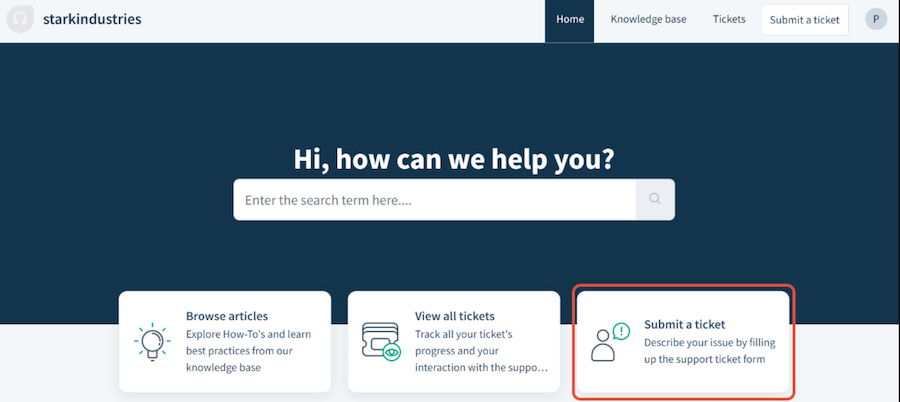
Freshdesk customer web portal (Source: Freshdesk)
2. Mobile Apps
While most web portals work fine on laptops and desktops, they’re not always optimized for viewing on today’s smartphones. Between features that aren’t compatible with mobile operating systems to issues with formatting, mobile users can experience a slew of issues when trying to access various websites on their smartphone’s web browser. As a result, more and more software developers are creating dedicated apps for both the Android and iOS platforms.
Mobile apps fill in many of the gaps leftover by traditional web portals. Instead of forcing customers to use web portals that aren’t optimized for their devices, companies can cater to modern consumers with dedicated apps for their specific devices.
In some cases, smartphone apps offer features that aren’t available through web portals—such as SMS alerts and notifications. Other times, the smartphone app simply mimics the functionality of an established web portal for maximum efficiency and convenience, such as the Salesforce mobile customer portal below.

Salesforce customized mobile customer portal (Source: Salesforce)
3. Kiosks
In-store and in-office kiosks have been used for decades to provide customers with convenient self-service options. These include self-checkouts (SCOs) at the grocery store, retail lottery terminals, bill payment terminals, and even automated coffee vending machines that brew and blend the order according to customer specifications.
Electronic kiosks are beneficial in various ways. Not only do they benefit customers by letting them complete purchases or make payments without having to wait for a cashier or service agent, but they also benefit your company by lessening the need for human staff—especially during shifts that are normally slow to begin with.
Visit Kiosk Information Systems
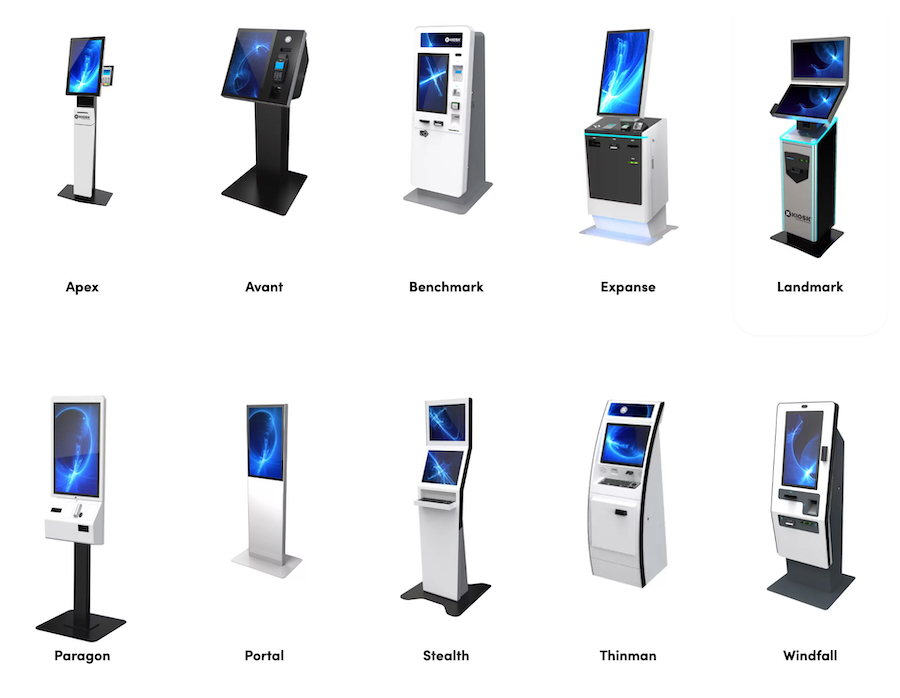
Kiosk Information Systems standard market-ready kiosks (Source: Kiosk Information Systems)
4. AI-driven Chatbots
Some of the most recent customer-facing applications take the form of artificial intelligence-driven (AI) chatbots. When done correctly, the consumers don’t even realize they’re talking to AI. While this form of AI is still in its infancy, it’s already proven highly effective when providing basic customer service, helping customers troubleshoot issues, and serving as a bridge until a live representative has the chance to intervene.
These chatbots use various algorithms and machine learning capabilities to mimic human speech while fulfilling the functions of traditional customer support staff. As expected, chatbots are commonly seen in customer service and support, as seen in the example from HubSpot CRM below.
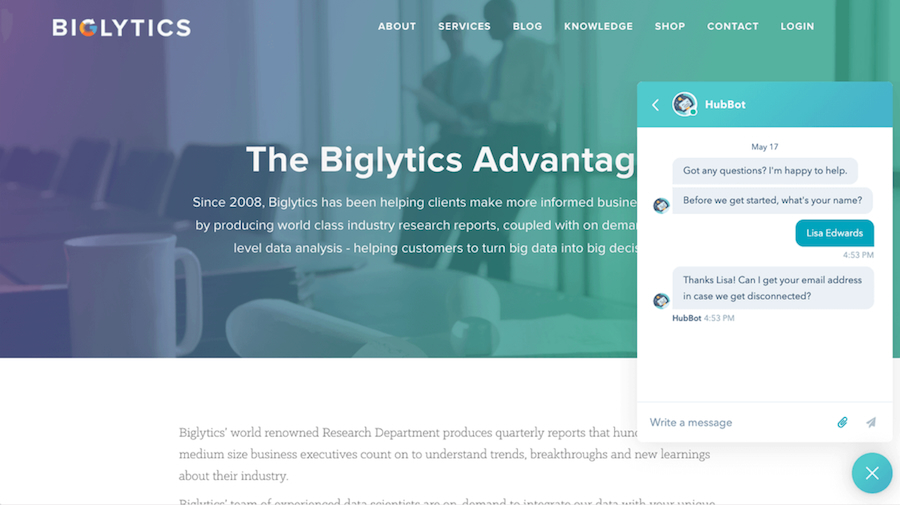
HubSpot CRM AI-powered conversational chatbot (Source: HubSpot)
Customer-facing Applications in Different Industries & Departments
Regardless of the different forms they may take, customer-facing applications are useful in virtually every industry. They make it possible for consumers to complete many basic and common tasks at their own pace while providing easy access to human service representatives as needed. Moreover, their digital nature makes it easy to collect data, compile informative reports, and generate actionable insights.
With ecommerce sales exceeding $280 billion in the fourth quarter of 2023 alone, it’s safe to say that consumers are embracing online shopping more than ever before. Some prefer full-scale ecommerce websites while others prefer shopping via smartphone apps. There are others still who prefer traditional, brick-and-mortar outlets—and customer facing applications cater to all of them.
Mobile and web-based ecommerce portals like Shopify let consumers browse products, add items to a virtual shopping cart, and pay via credit or debit card. SCOs and kiosks let customers complete their in-person purchases on their own, and smartphones are used to arrange pickups and deliveries. Customer-facing applications for small businesses are so ingrained into traditional sales management processes that they’ve already become the norm in many areas.
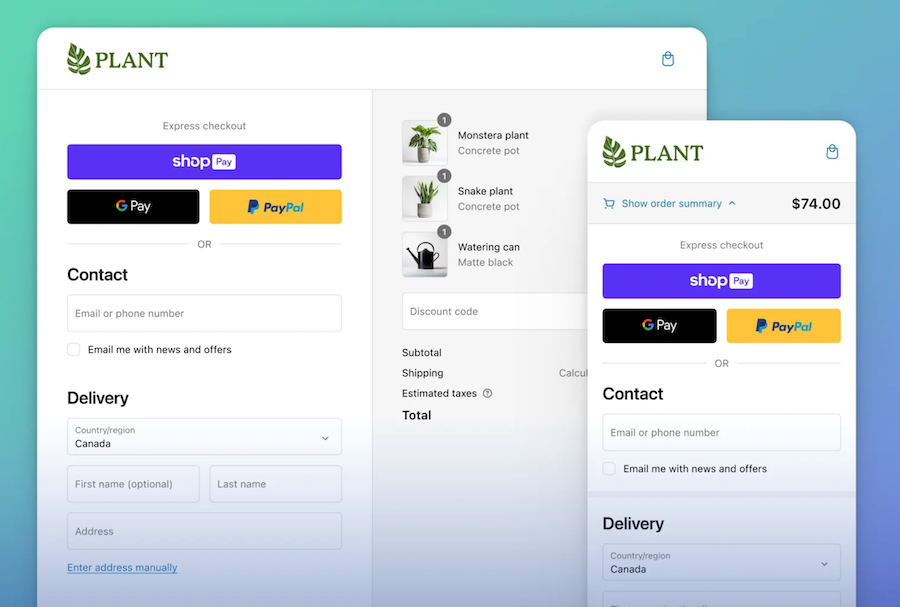
Shopify one-page checkout (Source: Shopify)
Customer-facing applications are very common in the Human Resources (HR) industry. In this case, the customers are actually the organization’s employees and potential new hires. Nonetheless, many of the same concepts still come into play. Some of the most popular customer facing applications examples in the HR industry include the following:
- Human resources management systems (HRMS)
- Recruitment and applicant tracking software (ATS)
- Customer relationship management (CRM) software
- Payroll, benefits administration, and employee rewards software
- Human capital management (HCM) software
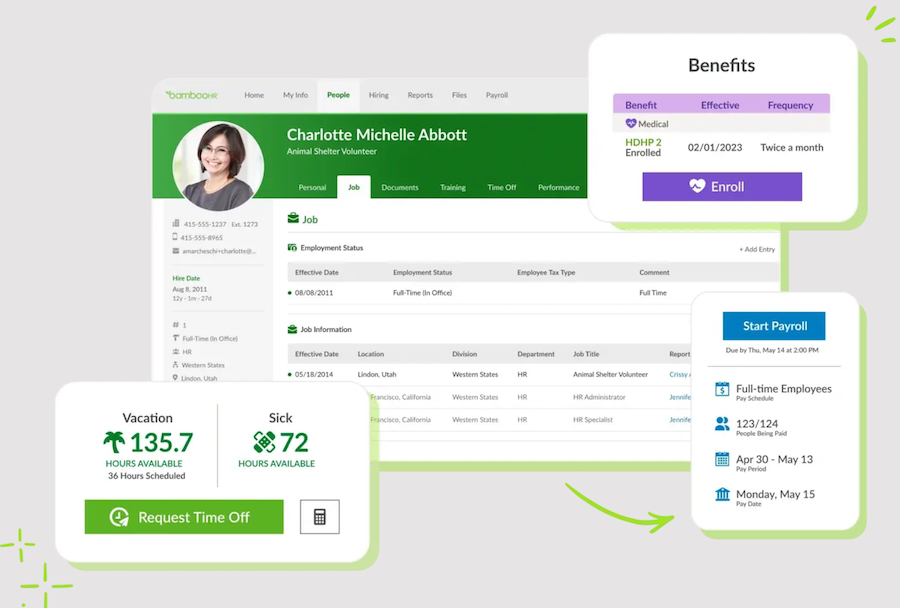
BambooHR employee management, benefits administration, time off, and payroll management features (Source: BambooHR)
As seen in the example from BambooHR, there may be some overlap between the solutions mentioned above. Nonetheless, they all have distinct purposes when managing and communicating with the general workforce.
Banks and other financial institutions often offer customer self-service web portals. These apps usually show the customer’s current balance, recent transaction history, and any scheduled payments or deposits. In many cases, these online banking portals also provide access to various account services and customer support.
Mobile apps are becoming more popular among banking and financial institutions like NBKC Bank. These are great for customers who are constantly on the move, since they can be accessed from virtually anywhere. In addition, they don’t require users to haul around a laptop computer to access a traditional website for their banking needs.
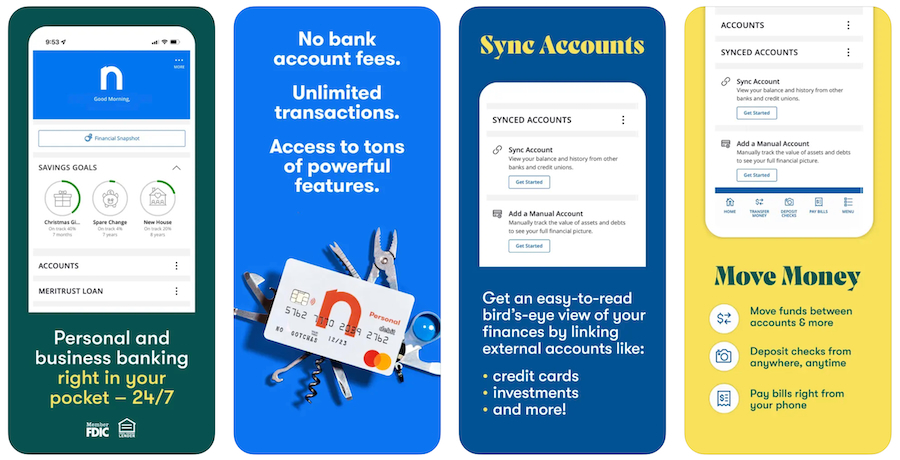
NBKC Bank mobile app (Source: App Store)
While modern consumers have been using the telephone to order takeout and delivery for years, most of these orders are given to a live service representative on the other end. Thanks to the rise of automated telephony systems, online menus, and smartphone apps, however, some orders aren’t even seen by a human until it’s time to cook the meal.
Even if a particular restaurant doesn’t offer online or smartphone ordering, there are numerous websites and services that will place, pick up, and deliver an order on your behalf. Popular examples include Uber Eats, DoorDash, and Grub Hub. To further entice customers, many of these services offer discounts that wouldn’t be available when making a purchase directly from the restaurant.
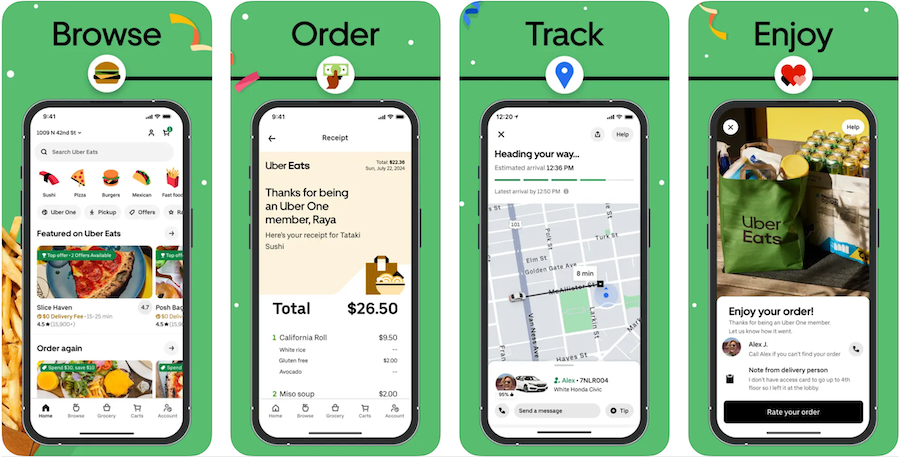
Uber Eats mobile app for ordering food on the go (Source: Apple App Store)
It wasn’t long ago when vehicle-less pedestrians relied on taxis, public transportation, and friends to get from point A to point B. With the increasing popularity of the internet, however, some organizations have developed customer-facing applications for the sole purpose of connecting pedestrians with short- and long-distance rides.
Not only do these customer-facing applications need to maintain apps for those looking for rides, but they also need separate apps for those who are offering their services. In certain regions, these platforms can be highly profitable for motivated individuals with fuel-efficient vehicles and plenty of time on their hands. Popular examples of transportation apps include Uber, Lyft, and Careem.
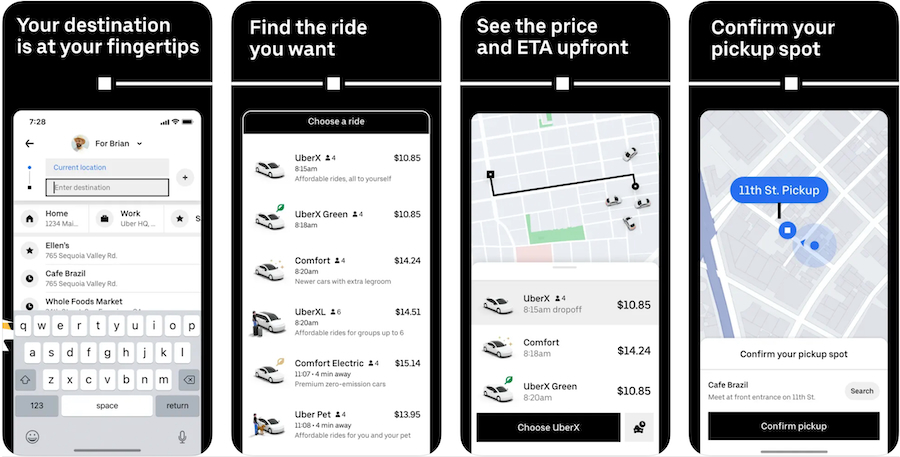
Uber mobile app for ride request (Source: Apple App Store)
It’s common for an organization to use multiple customer-facing applications simultaneously. Retail outlets that have in-person and online customers, for example, need to provide the same level of support regardless of where their customers originate. In cases like this, a company might implement a dedicated web portal alongside in-person kiosks and an automated support hotline. Popular examples of customer service software include Zendesk and Zoho Desk.
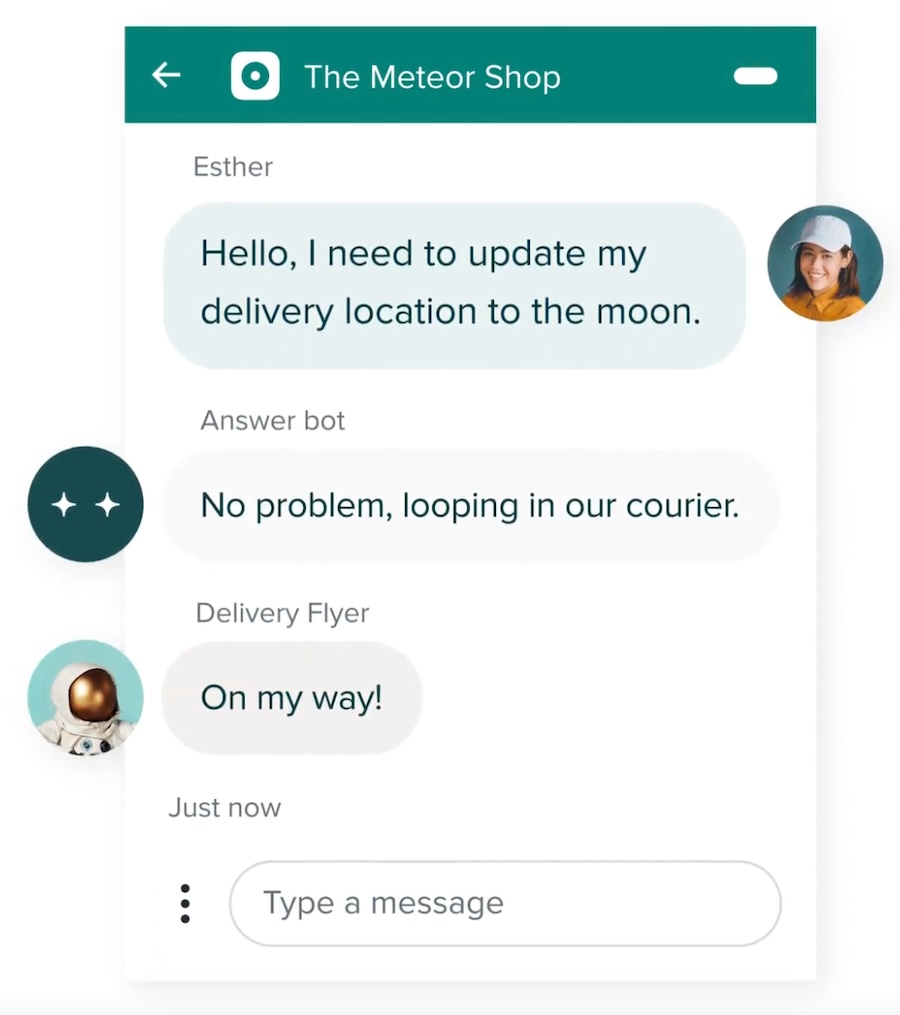
Zendesk interactive customer support (Source: Zendesk)
As a general rule of thumb, your company should always provide support through the same channels that your customers originate from—it’s your choice whether or not to offer service and support through other means.
How to Choose the Right Customer-facing Solution for You
It’s ultimately up to each organization to choose the customer facing apps that are right for their company. However, there are some helpful tips to keep in mind when considering your options.
- Ensure its relevance: Your chosen platform needs to be relevant to be useful. If most of your sales originate from your ecommerce site, for example, or if they prefer voice chat to handle service issues, you can probably skip the mobile app altogether and focus on your ecommerce web portal and automated telephony systems.
- Look for one that can showcase your products or services: Choose customer-facing solutions that make it easier to showcase your products and services. In many cases, this is a matter of understanding your customer demographics and catering to their preferences.
- Consider the level of customization: For best results, look for customer facing solutions that are customizable. Modern consumers want to use platforms that are familiar and comfortable, and many like to customize the look and feel with their favorite colors or graphics.
- Make sure it’s accessible to your team: Make sure your customer-facing applications are accessible on the backend by your teammates. If they’re not already familiar with these apps, you’ll have little choice but to train them or hire employees who already understand the technology at play.
Don’t forget to monitor the performance of your customer-facing solutions over the course of time. Not only will this help identify any challenges or bottlenecks in the platforms you already have, but it will also help you determine which solutions might be useful for your customers in the future.
Frequently Asked Questions (FAQs)
Consumer-facing or customer-facing refers to activities or roles that involve direct interaction or communication with customers. These interactions can occur either online or in-person.
Some examples of consumer-facing businesses are retail stores, hotels, and hospitals. Specific roles that are customer-facing are cashiers and sales reps in retail, concierges and front desk clerks in hotels, and receptionists and medical billers in hospitals.
Customers fall into four major categories: new, impulse, loyal, and problem customers. New customers are those that need to be welcomed and guided toward an informed decision about your product, and impulse customers are those that are most likely to leave a store instantly if they become disappointed. Loyal customers are those who keep coming back to your business for purchases, while problem customers are the ones who are unhappy with your service.
Bottom Line
From simplified mobile apps to sophisticated web portals, customer-facing applications are used every day and in nearly every industry. Whereas some provide the ability to order goods or sign up for services, others empower customers even further by giving them the ability to create and maintain accounts, manage their finances, and earn rewards. There’s no one-size-fits-all solution here—it’s up to the needs of your organization, your staff, and your customers.